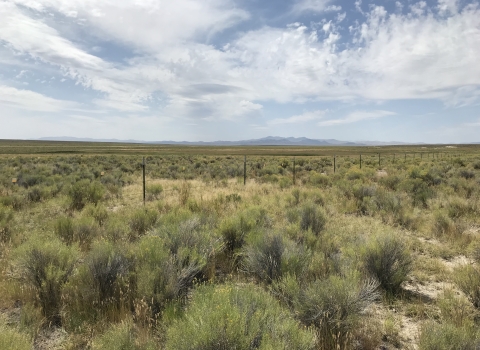Scattered across the semiarid landscape of the western United States is a hardy and unassuming shrub known as sagebrush. Branched with silvery green foliage and a pungent and herbal aroma, the iconic sagebrush anchors life on the land where it grows. Drought-resistant due to deep-set roots, the native western plant provides food and resources for wildlife and helps support native grasses that are also important for grazing livestock. Yet increasing land use changes, invasive annual grasses, devastating wildfires and climate change climate change
Climate change includes both global warming driven by human-induced emissions of greenhouse gases and the resulting large-scale shifts in weather patterns. Though there have been previous periods of climatic change, since the mid-20th century humans have had an unprecedented impact on Earth's climate system and caused change on a global scale.
Learn more about climate change have led to sagebrush lands becoming degraded and fragmented. Recognizing the cultural, economic and ecological importance of sagebrush lands, the U.S. Fish and Wildlife Service and partners are working together to turn the tide.
Hope for sagebrush is growing along with funding support. Starting in 2022, the Service is receiving $10 million in Bipartisan Infrastructure Law funding to strengthen the resilience of America’s sagebrush ecosystem. Current sagebrush funding is dedicated to on-the-ground projects and critical science needs to combat drought, invasive species invasive species
An invasive species is any plant or animal that has spread or been introduced into a new area where they are, or could, cause harm to the environment, economy, or human, animal, or plant health. Their unwelcome presence can destroy ecosystems and cost millions of dollars.
Learn more about invasive species , wildfire and climate change. Funding will continue through 2027, marking the Bipartisan Infrastructure Law as a historic investment in the health of sagebrush lands across the American West.
With sagebrush country spread across 175 million acres of public and private land within 13 western states, conservation actions to protect and restore sagebrush can be addressed strategically at the landscape scale with local implementation. Convening partners and fostering collaborations are often the most critical needs for successful implementation of landscape conservation, and at times, the most difficult for partners to address.
Program Spotlight
U.S. Fish and Wildlife Service programs are joining forces in support of sagebrush conservation, each bringing their unique expertise to bear. As the Service’s programmatic lead for large landscape conservation and science support, Science Applications serves as a convener and a facilitator in support of science-based large landscape collaboratives. In the world of sagebrush, this means assisting with cross-programmatic collaboration, as well as bringing together external partners.
Placing an emphasis on actionable science, Science Applications contributes to multiple projects within the sagebrush biome in support of the Service’s priorities to conserve native wildlife and plants, support rangeland health, and grow private landowner partnerships and public access. In the West, Science Applications works to address the negative impacts of wildfire and other ecosystem threats in sage-steppe habitat to support sage-grouse and other wildlife that depend on sagebrush to survive.
Interested in learning more about the U.S. Fish and Wildlife Service’s role in sagebrush conservation?
Access a complete list of Bipartisan Infrastructure Law funded sagebrush projects.




